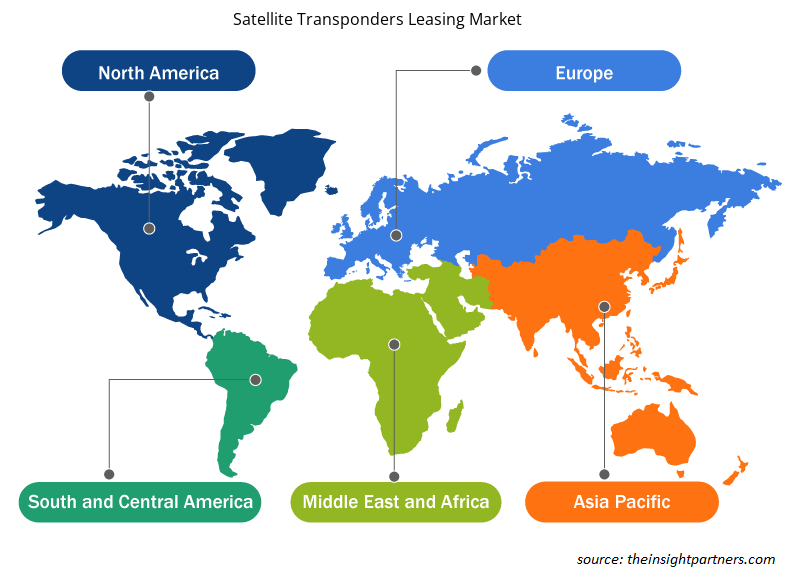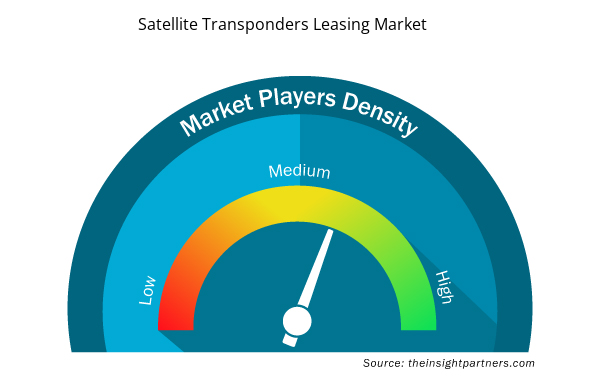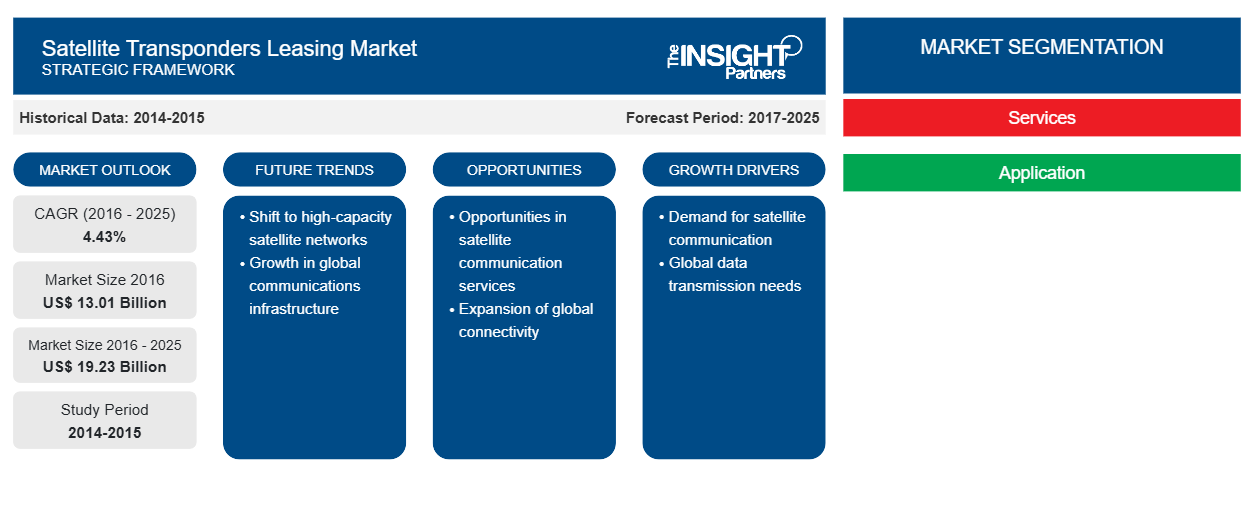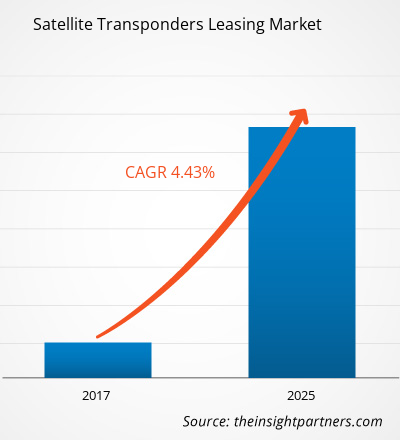Der Markt für die Vermietung von Satellitentranspondern dürfte von 13,01 Milliarden US-Dollar im Jahr 2016 auf 19,23 Milliarden US-Dollar im Jahr 2025 wachsen, was einer durchschnittlichen jährlichen Wachstumsrate (CAGR) von 4,43 % zwischen 2016 und 2025 entspricht.
Der Markt für Satellitentransponder-Leasing wird voraussichtlich sowohl in Bezug auf die Abdeckung als auch auf die Kapazität wachsen, da Ka-Band- und Ku-Band-Frequenzen das Marktwachstum ankurbeln. Darüber hinaus wird erwartet, dass die steigende Zahl von Abonnenten-Updates und neuen Abonnenten den globalen Markt für Satellitentransponder ankurbeln wird. Darüber hinaus wird aufgrund der aktuellen technologischen Fortschritte in der Satellitenkommunikation mit der Entstehung mehrerer neuer Anwendungen für Satellitentransponder gerechnet. Diese Satelliten gelten als leistungsstark genug, um mit ihrer Konkurrenz, dem Digital Subscriber Line (DSL)-Breitband, zu konkurrieren. All diese Faktoren werden voraussichtlich den globalen Markt für Satellitentransponder-Leasing im Prognosezeitraum ankurbeln.
Markteinblicke
Erweiterung der Ku-Band-Anwendungen soll neue Möglichkeiten für den Leasingmarkt für Kommunikationssatelliten-Transponder schaffen
Live-Übertragung und Videoverteilung sind einige der wichtigsten Einsatzmöglichkeiten von Ku-Band-Satelliten. Sie werden auch für verschiedene Datendienste verwendet, darunter VSAT-Dienste, Breitbandverbindungen, mobiles Backhaul sowie Luftfahrt- und Seefahrtsdienste. In dieser hochvernetzten Welt gelten all diese Anwendungen als entscheidend für das Funktionieren eines Unternehmens. Tatsächlich ist das Ku-Band das wichtigste Spektrum, das von Mobilitätsnetzwerken genutzt wird, um Breitbandverbindungen in Bereichen bereitzustellen, die terrestrische Netzwerke nicht erreichen können, nämlich über dem Ozean und in der Troposphäre. Das Ku-Band nimmt in Bezug auf die Bandbreite etwa 40 % des Marktes ein. Die Nachfrage nach Ku-Band-Transpondern dürfte aufgrund der zunehmenden Beliebtheit von Satellitenfernsehen insbesondere in den Entwicklungsländern steigen, was durch HD (High Definition) und die Nachfrage nach anderen ähnlichen Bandbreitenanwendungen weiter unterstützt wird. Die Entwicklung von 3D-Kanälen, die eine höhere Bandbreite verbrauchen und 50 % mehr Kapazität benötigen, dürfte dem Markt für Ku-Band-Satellitentransponder neuen Schwung verleihen. Gefolgt vom Ku-Band sind die C-Band-Transponder, die derzeit den größten Marktanteil haben, aber im Prognosezeitraum voraussichtlich einen stetigen Rückgang verzeichnen werden und ihre Bedeutung gegenüber dem Ku-Band und anderen ähnlichen Bandbreiten verlieren werden. Daher wird erwartet, dass diese Ausweitung der Ku-Band-Anwendungen neue Möglichkeiten für den Leasingmarkt für Satellitentransponder schafft.
Transponder-Leasing als Dienstleistung dominiert das globale Servicesegment des Satelliten-Transponder-Leasingmarktes
In den letzten ein bis zwei Jahren ist die Nachfrage nach geleasten Transpondern auf dem globalen Markt um 4,3-4,5 % gestiegen. Diese Zahl dürfte aufgrund der weltweit steigenden Transponderkosten weiter steigen. Auf dem Leasingmarkt für Satellitentransponder ist Europa die teuerste Region, gefolgt von Australien und Neuseeland. Südasien hingegen bietet die niedrigsten Leasingraten, weshalb der Asien-Pazifik-Raum in den kommenden Jahren als die vielversprechendste Region für den Leasingmarkt für Satellitentransponder gilt. Vor Kurzem hat das koreanische Satellitenunternehmen KT SAT einen Leasingvertrag für Transponder mit einem mongolischen Satellitenfernsehbetreiber unterzeichnet. Der Dienstanbieter KT SAT hat vier Transponder geleast, um den mongolischen Unternehmen DTH-Dienste anbieten zu können, die im kommenden Jahr eingeführt werden. Das Fernsehunternehmen DDISH wird voraussichtlich 2017 von den Diensten von KT SAT profitieren. Die Vermietung von Kommunikationssatellitentranspondern hängt in hohem Maße von der Einführung von HD-Videoübertragungen und der Verbreitung von High Dynamic Range (HDR)-Anwendungen ab. Allerdings wird erwartet, dass Leasingdienste den Markt für Satellitentransponder-Leasing mit einem relativ höchsten Marktanteil anführen werden, der jedoch Schwankungen unterliegt, die von der Änderung der Anschaffungskosten von Satellitentranspondern und den Gesamtkosten für den Start eines Satelliten und dessen Wartung abhängen.
Passen Sie diesen Bericht Ihren Anforderungen an
Sie erhalten kostenlos individuelle Anpassungen an jedem Bericht, einschließlich Teilen dieses Berichts oder einer Analyse auf Länderebene, eines Excel-Datenpakets sowie tolle Angebote und Rabatte für Start-ups und Universitäten.
- Holen Sie sich die wichtigsten Markttrends aus diesem Bericht.Dieses KOSTENLOSE Beispiel umfasst eine Datenanalyse von Markttrends bis hin zu Schätzungen und Prognosen.
Die Marktinitiative wurde als die am häufigsten angewandte Strategie auf dem globalen Markt für Satellitentransponder-Leasing angesehen. Einige der jüngsten Strategien einiger Akteure auf dem Markt für Satellitentransponder-Leasing sind unten aufgeführt:
2016: GlobalSat lizenziert Inmarsat Ka, L-Band-Dienste in ganz Mexiko
2016: MVS USA aktualisiert Satcom-Netzwerk mit Blick auf Cybersicherheit
2016: O3b und Ozonio bringen Breitband in eine weitere Amazonasstadt in Brasilien
2016: Afrikanische Schulen profitieren vom neuen Gazprom-Gilat-Deal
2016: Indonesien baut mit Newtec Breitbandzugang in unterversorgten Gebieten auf
Regionale Einblicke in den Markt für Satellitentransponder-Leasing
Die regionalen Trends und Faktoren, die den Markt für Satellitentransponder-Leasing im Prognosezeitraum beeinflussen, wurden von den Analysten von Insight Partners ausführlich erläutert. In diesem Abschnitt werden auch die Marktsegmente und die Geografie für Satellitentransponder-Leasing in Nordamerika, Europa, im asiatisch-pazifischen Raum, im Nahen Osten und Afrika sowie in Süd- und Mittelamerika erörtert.

- Erhalten Sie regionale Daten zum Leasingmarkt für Satellitentransponder
Umfang des Marktberichts zum Leasing von Satellitentranspondern
| Berichtsattribut | Details |
|---|---|
| Marktgröße im Jahr 2016 | 13,01 Milliarden US-Dollar |
| Marktgröße bis 2025 | 19,23 Milliarden US-Dollar |
| Globale CAGR (2016 - 2025) | 4,43 % |
| Historische Daten | 2014–2015 |
| Prognosezeitraum | 2017–2025 |
| Abgedeckte Segmente | Nach DienstenNach AnwendungNach Bandbreite |
| Abgedeckte Regionen und Länder | Nordamerika
|
| Marktführer und wichtige Unternehmensprofile |
|
Marktteilnehmerdichte: Der Einfluss auf die Geschäftsdynamik
Der Markt für Satellitentransponder-Leasing wächst rasant, angetrieben durch die steigende Nachfrage der Endnutzer aufgrund von Faktoren wie sich entwickelnden Verbraucherpräferenzen, technologischen Fortschritten und einem größeren Bewusstsein für die Vorteile des Produkts. Mit steigender Nachfrage erweitern Unternehmen ihr Angebot, entwickeln Innovationen, um die Bedürfnisse der Verbraucher zu erfüllen, und nutzen neue Trends, was das Marktwachstum weiter ankurbelt.
Die Marktteilnehmerdichte bezieht sich auf die Verteilung der Firmen oder Unternehmen, die in einem bestimmten Markt oder einer bestimmten Branche tätig sind. Sie gibt an, wie viele Wettbewerber (Marktteilnehmer) in einem bestimmten Marktraum im Verhältnis zu seiner Größe oder seinem gesamten Marktwert präsent sind.
Die wichtigsten auf dem Markt für die Vermietung von Satellitentranspondern tätigen Unternehmen sind:
- Intelsat
- SES
- Eutelsat
- Telesat
- SingTel Optus
Haftungsausschluss : Die oben aufgeführten Unternehmen sind nicht in einer bestimmten Reihenfolge aufgeführt.

- Überblick über die wichtigsten Akteure auf dem Markt für Satellitentransponder-Leasing
Globales Leasing von Satellitentranspondern – Marktsegmentierung
Nach Services
- Geschützt
- Ungeschützt
- Präemptiv
Nach Anwendung
- Regierung und Militär
- Telekommunikation
- Kommerziell
- Forschung & Entwicklung
- Navigation
- Fernerkundung
Nach Bandbreite
- Ku-Band
- Ka-Band
- C-Band
- Andere (S, L, X und K)
Nach Geografie
- Nordamerika
- UNS
- Kanada
- Mexiko
- Europa
- Russland
- Frankreich
- Deutschland
- Vereinigtes Königreich
- Luxemburg
- Restliches Europa
- Asien-Pazifik (APAC)
- China
- Indien
- Japan
- Restlicher Asien-Pazifik-Raum
- Naher Osten und Afrika (MEA)
- Saudi-Arabien
- Südafrika
- Israel
- Vereinigte Arabische Emirate
- Rest von MEA
- Südamerika (SAM)
- Brasilien
- Argentinien
- Rest von SAM
Firmenprofile
- Intelsat
- SES
- Eutelsat
- Telesat
- SingTel Optus
- MEASAT-Satellitensysteme
- Asiatischer Rundfunksatellit
- Arabsat
- ISRO
- China Satellitenkommunikationsgesellschaft.
- Historische Analyse (2 Jahre), Basisjahr, Prognose (7 Jahre) mit CAGR
- PEST- und SWOT-Analyse
- Marktgröße Wert/Volumen – Global, Regional, Land
- Branche und Wettbewerbsumfeld
- Excel-Datensatz



Report Coverage
Revenue forecast, Company Analysis, Industry landscape, Growth factors, and Trends

Segment Covered
This text is related
to segments covered.

Regional Scope
North America, Europe, Asia Pacific, Middle East & Africa, South & Central America

Country Scope
This text is related
to country scope.
Trends and growth analysis reports related to Aerospace and Defense : READ MORE..
The List of Companies - Satellite Transponders Leasing Market
- Intelsat
- SES
- Eutelsat
- Telesat
- SingTel Optus
- MEASAT satellite systems
- Asia Broadcast Satellite
- Arabsat
- ISRO
- China Satellite Communications Co.
The Insight Partners performs research in 4 major stages: Data Collection & Secondary Research, Primary Research, Data Analysis and Data Triangulation & Final Review.
- Data Collection and Secondary Research:
As a market research and consulting firm operating from a decade, we have published and advised several client across the globe. First step for any study will start with an assessment of currently available data and insights from existing reports. Further, historical and current market information is collected from Investor Presentations, Annual Reports, SEC Filings, etc., and other information related to company’s performance and market positioning are gathered from Paid Databases (Factiva, Hoovers, and Reuters) and various other publications available in public domain.
Several associations trade associates, technical forums, institutes, societies and organization are accessed to gain technical as well as market related insights through their publications such as research papers, blogs and press releases related to the studies are referred to get cues about the market. Further, white papers, journals, magazines, and other news articles published in last 3 years are scrutinized and analyzed to understand the current market trends.
- Primary Research:
The primarily interview analysis comprise of data obtained from industry participants interview and answers to survey questions gathered by in-house primary team.
For primary research, interviews are conducted with industry experts/CEOs/Marketing Managers/VPs/Subject Matter Experts from both demand and supply side to get a 360-degree view of the market. The primary team conducts several interviews based on the complexity of the markets to understand the various market trends and dynamics which makes research more credible and precise.
A typical research interview fulfils the following functions:
- Provides first-hand information on the market size, market trends, growth trends, competitive landscape, and outlook
- Validates and strengthens in-house secondary research findings
- Develops the analysis team’s expertise and market understanding
Primary research involves email interactions and telephone interviews for each market, category, segment, and sub-segment across geographies. The participants who typically take part in such a process include, but are not limited to:
- Industry participants: VPs, business development managers, market intelligence managers and national sales managers
- Outside experts: Valuation experts, research analysts and key opinion leaders specializing in the electronics and semiconductor industry.
Below is the breakup of our primary respondents by company, designation, and region:

Once we receive the confirmation from primary research sources or primary respondents, we finalize the base year market estimation and forecast the data as per the macroeconomic and microeconomic factors assessed during data collection.
- Data Analysis:
Once data is validated through both secondary as well as primary respondents, we finalize the market estimations by hypothesis formulation and factor analysis at regional and country level.
- Macro-Economic Factor Analysis:
We analyse macroeconomic indicators such the gross domestic product (GDP), increase in the demand for goods and services across industries, technological advancement, regional economic growth, governmental policies, the influence of COVID-19, PEST analysis, and other aspects. This analysis aids in setting benchmarks for various nations/regions and approximating market splits. Additionally, the general trend of the aforementioned components aid in determining the market's development possibilities.
- Country Level Data:
Various factors that are especially aligned to the country are taken into account to determine the market size for a certain area and country, including the presence of vendors, such as headquarters and offices, the country's GDP, demand patterns, and industry growth. To comprehend the market dynamics for the nation, a number of growth variables, inhibitors, application areas, and current market trends are researched. The aforementioned elements aid in determining the country's overall market's growth potential.
- Company Profile:
The “Table of Contents” is formulated by listing and analyzing more than 25 - 30 companies operating in the market ecosystem across geographies. However, we profile only 10 companies as a standard practice in our syndicate reports. These 10 companies comprise leading, emerging, and regional players. Nonetheless, our analysis is not restricted to the 10 listed companies, we also analyze other companies present in the market to develop a holistic view and understand the prevailing trends. The “Company Profiles” section in the report covers key facts, business description, products & services, financial information, SWOT analysis, and key developments. The financial information presented is extracted from the annual reports and official documents of the publicly listed companies. Upon collecting the information for the sections of respective companies, we verify them via various primary sources and then compile the data in respective company profiles. The company level information helps us in deriving the base number as well as in forecasting the market size.
- Developing Base Number:
Aggregation of sales statistics (2020-2022) and macro-economic factor, and other secondary and primary research insights are utilized to arrive at base number and related market shares for 2022. The data gaps are identified in this step and relevant market data is analyzed, collected from paid primary interviews or databases. On finalizing the base year market size, forecasts are developed on the basis of macro-economic, industry and market growth factors and company level analysis.
- Data Triangulation and Final Review:
The market findings and base year market size calculations are validated from supply as well as demand side. Demand side validations are based on macro-economic factor analysis and benchmarks for respective regions and countries. In case of supply side validations, revenues of major companies are estimated (in case not available) based on industry benchmark, approximate number of employees, product portfolio, and primary interviews revenues are gathered. Further revenue from target product/service segment is assessed to avoid overshooting of market statistics. In case of heavy deviations between supply and demand side values, all thes steps are repeated to achieve synchronization.
We follow an iterative model, wherein we share our research findings with Subject Matter Experts (SME’s) and Key Opinion Leaders (KOLs) until consensus view of the market is not formulated – this model negates any drastic deviation in the opinions of experts. Only validated and universally acceptable research findings are quoted in our reports.
We have important check points that we use to validate our research findings – which we call – data triangulation, where we validate the information, we generate from secondary sources with primary interviews and then we re-validate with our internal data bases and Subject matter experts. This comprehensive model enables us to deliver high quality, reliable data in shortest possible time.


 Holen Sie sich ein kostenloses Muster für diesen Bericht
Holen Sie sich ein kostenloses Muster für diesen Bericht